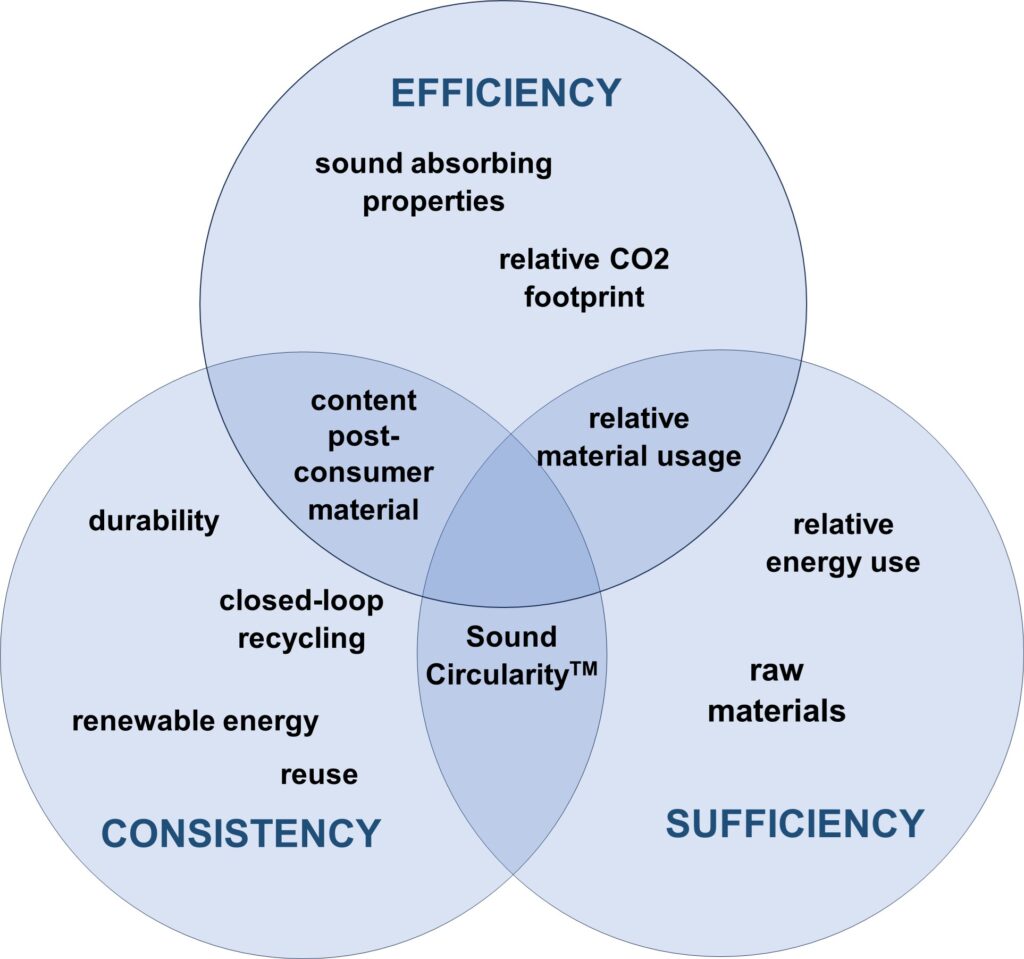
The 50th Annual Congress of the German Acoustical Society (DAGA) was held in Hannover this year. Celebrating decades of innovation and scientific advancement, DAGA 2024 featured presentations dedicated to sustainable practices in acoustic research and technology. This article provides a summary of the presentation by Achim Klein from Ecophon Saint-Gobain on the efficiency, consistency, and sufficiency of glass wool absorbers.
Glass wool as the base material for porous absorbers combines several aspects that can contribute to more sustainable buildings: from a technical point of view, glass wool guarantees highly absorbent properties (in accordance with ISO 11654) with a low material thickness due to its specific density and flow resistance. The use of post-consumer material and the closing of material cycles through the reuse or recycling of absorbers are also becoming increasingly important. In this article, the sustainability aspects of glass wool are presented and categorised according to the three strategies towards greater sustainability.
The importance of embodied carbon emissions
One of the most significant environmental policy goals is the reduction of carbon dioxide (CO2) emissions. This was agreed upon as part of the 2015 Paris Climate Agreement, which set global targets for reducing CO2 emissions. The building sector contributes significantly to CO2 emissions on a global scale. Until recently, the built environment sector has concentrated its efforts on measuring and reducing operational carbon emissions. Those emissions generated by a building in use can be attributed to two primary sources: those created by the individuals responsible for managing the building and those produced by the occupants of the building. In recent years, it emerged that it is equally important to consider the embodied carbon emissions. These are emissions from the production and transport of building materials, and from the construction and demolition of buildings. A significant proportion of these emissions are generated prior to the occupation of the building. Consequently, it is essential to pay particular attention to the CO2 footprint of building materials over their complete life cycle.
The three strategies towards greater sustainability
In the context of sustainable construction, the efficiency, consistency and sufficiency of building materials are of paramount importance, as they influence all sustainability dimensions of a building simultaneously.
- Efficiency is defined as the optimal utilisation of available resources. It is linked to technical considerations and also to systemic approaches to solutions.
- Consistency refers to the transition to sustainable technologies. Ecosystems should be utilised without destroying them in the process. It is therefore about thinking and acting in cycles.
- The concept of sufficiency is concerned with finding the right balance when it comes to consumption and production.
Environmental Product Declarations (EPDs)
The analysis of the life cycle of building materials and buildings is an essential aspect of sustainable construction. This encompasses not only the planning and construction phases, but also the provision of raw materials and their subsequent disposal at the end of their useful life. The analysis of the entire life cycle of buildings and materials, as well as their environmental impact, requires a different type of planning approach and an examination of the physical performance that materials can provide. EPDs are 3rd party verified and provide insights into a building material’s environmental impact.
Functional Unit (FU)
The so-called functional unit (FU) is an essential of part of an EPDs as it provides information about the physical performance of a material in relation to its carbon footprint.
The efficiency of glass wool absorbers
The functional unit of studied absorbers made of glass wool corresponds to 1m² of highly absorbent absorber of sound absorber class A (according to ISO 354 and a depth construction height of 200mm). All studied absorbers made of glass wool are assessed according to this standard. Linking the sound-absorbing properties of the product via the FU with the CO2 footprint enables comparability and a direct assessment of efficiency. Every use of material results in a consumption of energy and an environmental impact due to the associated flow of resources which is why this approach is so important.
Putting glass wool absorbers into perspective
The three strategies towards greater sustainability can provide a framework for assessing building materials’ properties.
Illustration below shows an example of a contextualisation of glass wool absorbers according to these three strategies towards greater sustainability.

When prioritising the conservation of resources in the selection of materials, two aspects must be taken into account. Firstly, it is necessary to consider the current possibilities for conserving resources through sufficiency and the use and recycling of building materials that are already available in the cycle (consistency). Secondly, future needs must be taken into account to ensure that the building materials used can also be utilised effectively in the future.

